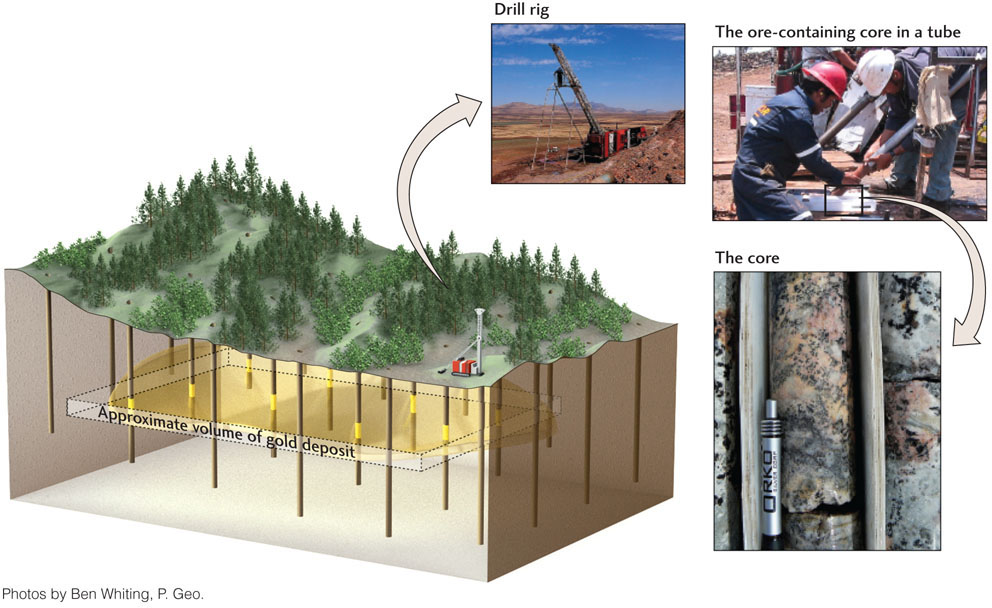Practicing Geology Exercise
Is It Worth Mining?
Geologists employed by the Rocks-r-Us Corporation have discovered basaltic volcanic rocks laced with gold. The corporate executives ponder their figures and measurements and study their three-dimensional model of the ore mineral deposit, but in the end they have just one question: Should we open a mine?
Exploration for ore minerals is an important and challenging activity that employs many geologists. Finding a promising deposit is only the first step toward extracting useful materials, however. The shape of the deposit, and the distribution and concentration of the ore, must be estimated before mining begins. This is done by drilling closely spaced holes and obtaining continuous cores through the ore deposit and the surrounding rock. Information from the cores is used to create a three-dimensional model of the ore deposit. That model is then used to evaluate whether or not the deposit is large enough and has a high enough concentration of minerals to justify opening a mine. Geologists contribute key information of direct economic significance to this very practical decision-making process.
The planning of mining operations is typically based on chemical and mineralogical analyses of the extracted cores, from which two quantities are calculated:
 Grade refers to the concentration of ore minerals within economically valueless parent rock (referred to as waste rock).
Grade refers to the concentration of ore minerals within economically valueless parent rock (referred to as waste rock). Mass refers to the amount of ore that could potentially be extracted from the deposit.
Mass refers to the amount of ore that could potentially be extracted from the deposit.

Both quantities are important because neither grade nor mass alone is sufficient to identify an economically valuable deposit. For example, the grade could be locally very high in veins, but the overall mass could be low because the veins are rare. In another case, the mass might be high, but the ore minerals might be so dispersed within the waste rock that the costs of processing it to extract the ore would become too high. Thus, the ideal ore deposit is one that has both high grade and high mass.
88
Grade is calculated by determining the percentage of ore minerals within a volume of rock. Laboratory analysis of core samples provides this measurement. Mass is calculated by assigning the grade value determined for individual cores to the unknown volume of rock between drill holes. Mass is the amount of ore that could be extracted if all of it could be extracted from the rock, but it is rare that all of it can be. In the parlance of the mining industry, mass is often calculated in tons and referred to as tonnage because of the enormous volumes of rock that are involved.
Drilling and analysis of core samples has shown that the gold in the Rocks-r-Us deposit has an average grade of 0.02 percent across all cores. The deposit has been determined to have a rectangular geometry extending laterally for 50 meters in one direction and 1500 meters in the other, with a thickness of 2 meters.
What is the volume of the ore deposit?

What is the volume of gold in the ore deposit?

Given that gold has a density of 19 g/cm3 (about 6800 ounces/m3), what is the mass of the gold in ounces?

The price of gold is typically reported in dollars per ounce. At the time of this writing, the price of gold is roughly $800/ounce. What is the potential value of this ore deposit?

BONUS PROBLEM: You bring this information to a meeting with the Rocks-r-Us corporate executives. They calculate that, over its lifetime, the mine will cost about $120,000,000 to operate, including restoration of the land after mining is completed. Is the value of the gold worth it? What simple calculation will give you the answer?